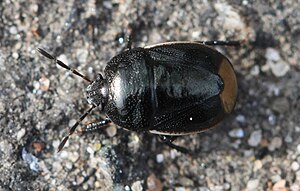Legnotus limbosus
| Legnotus limbosus | ||||||||||||
|---|---|---|---|---|---|---|---|---|---|---|---|---|

Legnotus limbosus |
||||||||||||
| Systematics | ||||||||||||
|
||||||||||||
| Scientific name | ||||||||||||
| Legnotus limbosus | ||||||||||||
| ( Geoffroy , 1785) |
Legnotus limbosus is a bug from the family of earth bugs (Cydnidae).
features
The bugs become 3.5 to 4.5 millimeters long. They are black in color and have a pale side edge on the corium of the hemielytras . This almost reaches the membranes of the hemielytres. The species is similar to Legnotus picipes , but only the basal part at the edge of the corium is pale in color. In addition, the forehead wedge ( tylus ) in the similar species is of the same length as the cheeks that border it; in Legnotus limbosus , it is significantly shorter.
distribution and habitat
The species is distributed from western North Africa across the Mediterranean to northern Europe, but is absent in the far north. In the east it occurs to Central Asia. The species is widespread in Central Europe and is often not uncommon. The animals are found in warm, dry to moist habitats, preferably with sandy soils and generally without woody vegetation. However, shading is tolerated.
Way of life
The animals live on bedstraws ( Galium ), such as real bedstraw ( Galium verum ), burdock bedstraw ( Galium aparine ) or meadow bedstraw ( Galium mollugo ). The nymphs in particular live on the ground under these plants. The adults and only less often the nymphs can be found on mint family (Lamiaceae) such as ziesten ( Stachys ), dead nettles ( Lamium ), thyme ( Thymus ) and germander ( Teucrium ). Hibernation often takes place in aggregations in the ground litter and in moss near the food plants. Mating takes place in May and June. During this time, the females can also be observed guarding their eggs. The nymphs appear mainly in June and July, but also into August. The adult animals of the new generation can be found from late July or early August. They are hardly active, but apparently immediately prepare for wintering. One generation is trained every year.
supporting documents
Individual evidence
- ↑ a b c Wachmann: Wanzen , Vol. 4, p. 16
- ↑ Legnotus limbosus. British Bugs, accessed June 20, 2014 .
literature
- Ekkehard Wachmann , Albert Melber, Jürgen Deckert: Bugs. Volume 4: Pentatomomorpha II: Pentatomoidea: Cydnidae, Thyreocoridae, Plataspidae, Acanthosomatidae, Scutelleridae, Pentatomidae. (= The animal world of Germany and the adjacent parts of the sea according to their characteristics and their way of life . 81st part). Goecke & Evers, Keltern 2008, ISBN 978-3-937783-36-9 .
Web links
- Legnotus limbosus in Fauna Europaea. Retrieved June 20, 2014
